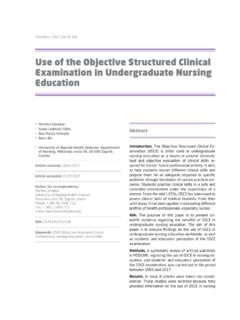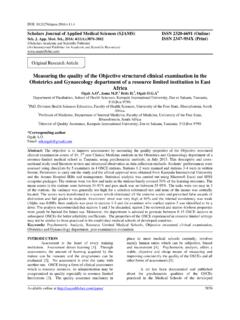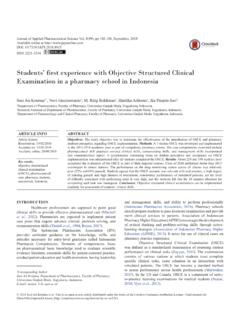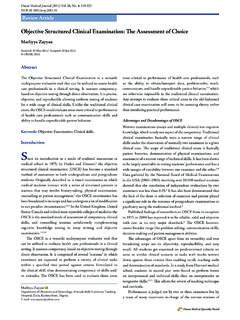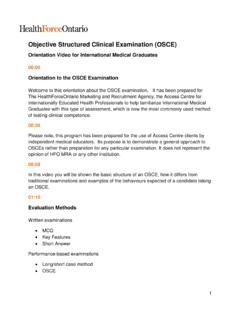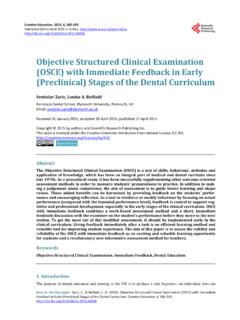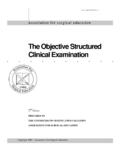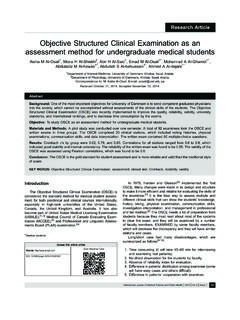Transcription of Interprofessional Objective Structured Clinical ...
1 Shinnick Page 1 Interprofessional Objective Structured Clinical examination (IP-OSCE) MaryAnn Shinnick PhD, ACNP and Elizabeth O Gara BACKGROUND The Objective Structured Clinical examination (OSCE) is used in almost all North American Medical Schools to assess Clinical skills. In the 2012 AAMC Graduation Questionnaire, 73% of all seniors reported that an OSCE was used in assessing their Clinical skills during the core clerkships. The traditional OSCE as developed by Harden (1979) consists of multiple brief encounters during which a student is expected to complete a targeted Clinical task or conduct a patient encounter.
2 Scores are typically provided on data collection skills and communication. Variations on the OSCE have been developed to assess team behavior using videos and a medical and nursing. Both of these variations could be utilized in the traditional multi-station format, which has the advantage over more elaborate single instance technology-enriched simulations of producing a reliable estimate of performance. In this newly developed and innovative Interprofessional OSCE (IP-OSCE), we use one OSCE with a patient and a nurse portrayed by actors and one OSCE in which actual Nurse Practitioner (NP) and medical students are required to collaborate in caring for a standardized patient in the ambulatory setting.
3 This IP-OSCE tool assessed whether or not students have attained the IPE Competencies in the areas communication and teamwork. The IP-OSCE tool has two activities; one a formative assessment and another summative assessment. IMPLEMENTATION A. Tool Name: Interprofessional Objective Structured Clinical examination (IP-OSCE) B. Participants: 3rd year Medical Student or 2nd year Nurse Practitioner Student C. Setting: The IP-OSCEs can be used within a Clinical simulation environment for an IPE classroom setting either for measurement of class pre/post skill development or for individual assessment.
4 D. Requirements: Completed in person, individual performance is assessed in a prepared Clinical simulation. E. IPEC Competencies: Communication, Teamwork Shinnick Page 2 F. Administration: Administration of this OSCE to an Interprofessional team requires a Standardized Patient (SP), medical and NP students. An example of how this can be done is described here. At UCLA, medical students at the end of the third year are required to pass an 8 station OSCE in order to graduate. The OSCE is scored for Clinical skills and Clinical judgment (percent of critical items).
5 The stations usually consist of a student and a standardized patient or occasionally, a family member, patient, and the student. In this newly developed and innovative OSCE for Interprofessional education, we have used the OSCE with a patient and a nurse portrayed by actors as well as the OSCE in which actual nursing and medical students are required to collaborate in caring for a standardized patient in the ambulatory setting. Although this is similar to IP encounters currently being assessed using full body simulators, the OSCE station mirrors the type of collaborative practice essential in the ambulatory setting.
6 As with all OSCE stations, the SP script, training materials, scoring checklist, and standard setting have been pilot tested, paying particular attention to the correlation with the more traditional OSCE stations. The particular value of these types of stations is that they can be inserted into an existing OSCE to add a dimension of collaborative practice. G. Recommended uses: As an assessment tool: This type of OSCE can be used to assess Interprofessional knowledge, communication and teamwork. It can also be used to assess each student s ability to problem solve in a case of a patient with minimal resources.
7 As an instructional tool: A robust debriefing with trained faculty after this OSCE can assist in instruction by exploring decisions made by the students, alternative solutions and can clarify any misconceptions, For evaluating a course or program: Summative evaluation of student s knowledge and performance in key areas of the IP-OSCE can assist in evaluation of IP content delivered to the participants in an IP program. H. Strategies for providing results to students Knowledge test results can be delivered to students at the conclusion of the OSCE(s) or the online assessment.
8 Potential results may include differences in IP knowledge from pre-OSCE to post-OSCE, Clinical judgment and skill performance, IP competencies of teamwork and communication. It is imperative the meaning of the results be conveyed to the students. In the pilot Shinnick Page 3 testing of these OSCEs, one NP faculty member was able to review all of the video performances of the NP students and provide them with a detailed analysis of their performance with specific suggestions for the future. I. Challenges: a. Topic. The project team was testing instruments which involved Interprofessional communication and teamwork.
9 Therefore, a patient problem in which these skills could be used became the focus of both of the OSCEs. b. Setting. Since the majority of the NP students in the nursing program are experienced nurses employed in a hospital, several who work in an ICU or other acute setting such that physician collaboration is common, they could have an edge if the setting was designed to be in the hospital. The NP students would be less likely to control the OSCE if they were put in a less familiar setting, such as a clinic. This is appropriate as both the student groups were being familiarized with the clinic setting in their training.
10 C. Development of the Situation. In writing an OSCE, persons experienced with the specialty areas is essential. One who trains medical doctors does not know what a nurse or NP knows or should know. The reverse is also true. Therefore, an experienced NP (Mary Ann Shinnick) wrote the OSCE, objectives , case, and roles for the NP while the SP and OSCE writing expert in the David Geffen UCLA School of Medicine (DGSOM) drafted the roles for the patient and the MS (Elizabeth O Gara). d. Agenda. MS and NP Students were given 20 min of instruction for the OSCE event.
